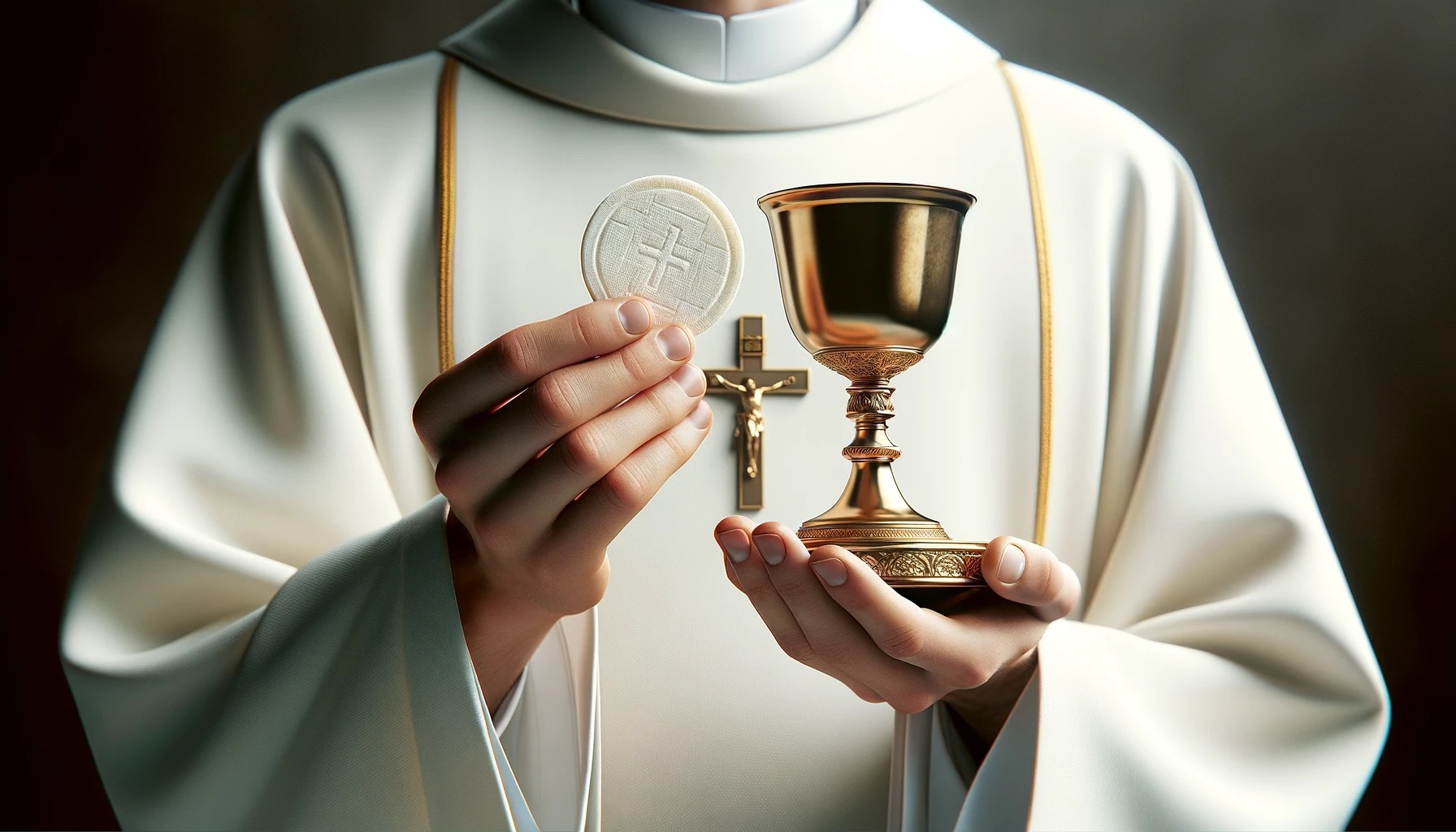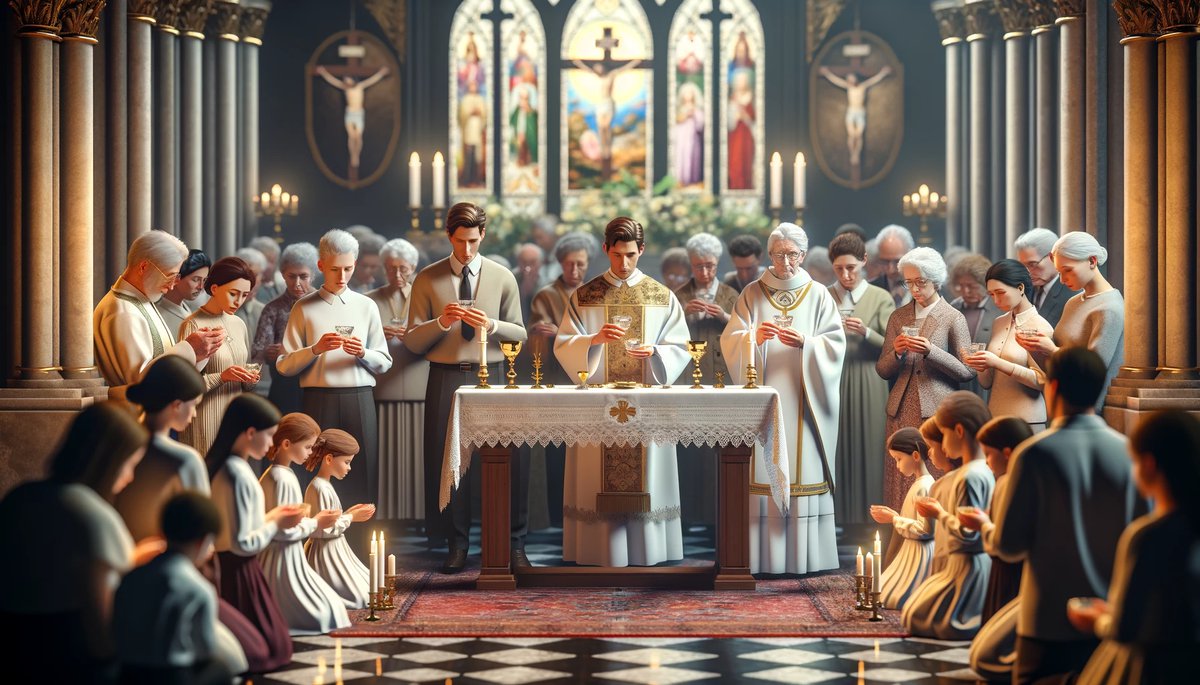Home>Theology and Spirituality>What Does Holy Communion Symbolize


Theology and Spirituality
What Does Holy Communion Symbolize
Published: February 19, 2024
Ericka Andersen, an editor at Christian.net, expertly merges digital strategy with content creation, focusing on faith and societal issues. Her communication skills enhance the platform's engaging narratives, fostering meaningful dialogue on belief's impact on society.
Discover the significance of Holy Communion in theology and spirituality. Explore the symbolic meaning and importance of this sacred Christian practice. Unlock the deeper spiritual understanding of the Eucharist.
(Many of the links in this article redirect to a specific reviewed product. Your purchase of these products through affiliate links helps to generate commission for Christian.net, at no extra cost. Learn more)
Table of Contents
Introduction
Holy Communion, also known as the Eucharist or the Lord's Supper, holds profound significance in Christian theology and spirituality. It is a sacred ritual that has been practiced for centuries, serving as a central element of worship in many Christian traditions. The act of partaking in the bread and wine symbolizes the spiritual nourishment and unity of believers, as well as the remembrance of Jesus Christ's sacrificial death and resurrection.
The history, symbolism, and spiritual implications of Holy Communion are rich and multifaceted, offering a deep well of contemplation and reverence for those who participate in this sacred rite. As we delve into the origins and meaning of Holy Communion, we gain insight into its enduring relevance and the profound impact it has on the faith and spiritual lives of believers around the world.
Read more: What Is The Symbol Of Holy Communion
The History of Holy Communion
The history of Holy Communion can be traced back to the Last Supper, a significant event in the life of Jesus Christ. According to the Gospels of Matthew, Mark, and Luke, Jesus shared a final meal with his disciples before his crucifixion. During this meal, he took bread, blessed it, broke it, and gave it to his disciples, saying, "Take, eat; this is my body." He then took a cup of wine, gave thanks, and offered it to them, saying, "Drink from it, all of you; for this is my blood of the covenant, which is poured out for many for the forgiveness of sins."
Following this event, Jesus instructed his disciples to continue this practice in remembrance of him. The early Christian community, deeply influenced by the teachings and actions of Jesus, incorporated the communal sharing of bread and wine into their worship gatherings. This practice became known as the Eucharist, derived from the Greek word for thanksgiving, reflecting the spirit of gratitude and remembrance inherent in the ritual.
As Christianity spread and evolved, the observance of the Eucharist became a central feature of Christian worship. The early church fathers, such as Ignatius of Antioch and Justin Martyr, wrote about the significance of the Eucharist in the life of the Christian community, emphasizing its connection to the sacrificial death and resurrection of Jesus Christ.
Over time, various Christian traditions developed distinct liturgical practices and theological interpretations of the Eucharist. The Roman Catholic Church, Eastern Orthodox Church, and Protestant denominations each have their unique perspectives on the nature of the Eucharist, yet all recognize its foundational importance as a means of grace and spiritual nourishment for believers.
The history of Holy Communion is marked by a rich tapestry of theological reflection, liturgical diversity, and spiritual devotion. It stands as a testament to the enduring legacy of Jesus' Last Supper and the profound impact it has had on the worship and spiritual life of Christian communities throughout history.
The Symbolism of Bread and Wine
The symbolism of bread and wine in the context of Holy Communion is deeply rooted in the teachings and actions of Jesus Christ. In the Christian tradition, these elements hold profound significance, representing spiritual truths and serving as tangible symbols of the believer's faith and participation in the life of Christ.
Bread
The use of bread in Holy Communion harkens back to the words of Jesus during the Last Supper, where he took bread, blessed it, and gave it to his disciples, declaring, "Take, eat; this is my body." This act of sharing bread symbolizes the broken body of Christ, signifying his sacrificial death on the cross for the redemption of humanity. The act of partaking in the bread serves as a poignant reminder of Jesus' selfless love and the atoning significance of his death, inviting believers to reflect on the profound depth of his sacrifice.
Wine
Similarly, the use of wine in Holy Communion carries profound symbolism, as Jesus presented the cup of wine to his disciples, stating, "Drink from it, all of you; for this is my blood of the covenant, which is poured out for many for the forgiveness of sins." The wine symbolizes the blood of Christ, representing the new covenant between God and humanity, sealed through the shedding of Jesus' blood on the cross. By partaking in the wine, believers acknowledge the transformative power of Christ's sacrifice, which brings forgiveness, reconciliation, and spiritual renewal.
Read more: What Does The Wine Symbolize In Communion
Unity and Nourishment
Moreover, the act of sharing bread and wine in a communal setting underscores the unity and fellowship of believers within the body of Christ. It serves as a tangible expression of the shared faith and spiritual bond that unites Christians across diverse backgrounds and traditions. Additionally, the spiritual nourishment derived from partaking in the bread and wine signifies the sustenance and sustenance of the believer's faith, providing strength, sustenance, and spiritual sustenance for the journey of discipleship.
In essence, the symbolism of bread and wine in Holy Communion encapsulates the central tenets of the Christian faith, embodying the sacrificial love of Christ, the transformative power of his atonement, and the unity and spiritual nourishment of the believing community. As believers partake in these elements, they are invited to enter into a profound encounter with the living Christ, embracing the depth of his love and the transformative grace extended through his sacrificial death and resurrection.
The Act of Remembering
The act of remembering holds a central place in the observance of Holy Communion. When Jesus instituted the Last Supper, he instructed his disciples to partake in the bread and wine in remembrance of him. This call to remembrance serves as a poignant reminder of the sacrificial love and redemptive significance of Christ's death and resurrection.
In the act of remembering, believers are invited to reflect on the profound depth of Jesus' sacrifice, recognizing the selfless love that compelled him to offer himself for the salvation of humanity. It serves as a spiritual exercise, drawing individuals into a contemplative space where they can meditate on the transformative power of Christ's atoning work.
The act of remembering also fosters a deep sense of gratitude within the hearts of believers. As they partake in the bread and wine, they are reminded of the immense grace and mercy extended to them through Christ's sacrifice. This remembrance engenders a spirit of thankfulness, as individuals acknowledge the unmerited gift of salvation and the new life made possible through the redemptive work of Jesus.
Furthermore, the act of remembering serves to connect believers across time and space. As they participate in Holy Communion, they join with the countless generations of Christians who have faithfully observed this sacred ritual throughout history. This sense of continuity and unity in remembrance reinforces the communal nature of the Christian faith, transcending individual experiences and binding believers together in a shared heritage of faith.
In essence, the act of remembering in Holy Communion is a profound and transformative practice. It invites believers to engage with the foundational truths of the Christian faith, to express gratitude for the boundless grace of God, and to unite with the global community of faith in a timeless act of remembrance. Through this sacred observance, individuals are drawn into a deeper awareness of Christ's presence and a renewed commitment to embody the love and grace exemplified in his sacrificial offering.
The Communion of Believers
The act of partaking in Holy Communion not only symbolizes the spiritual nourishment and remembrance of Christ's sacrifice but also embodies the profound communion of believers within the body of Christ. As individuals gather to share in the bread and wine, they enter into a sacred fellowship that transcends earthly boundaries and denominational distinctions.
At its core, the communion of believers in Holy Communion reflects the unity and interconnectedness of the global Christian community. Regardless of cultural, linguistic, or doctrinal differences, believers come together at the communion table, united by their shared faith in Jesus Christ. This unity finds expression in the act of partaking in the same elements – the bread and wine – symbolizing the common bond that believers share in their devotion to Christ.
Moreover, the communion of believers extends beyond the immediate gathering, encompassing the timeless communion of saints throughout history. As individuals participate in Holy Communion, they join with the countless generations of Christians who have faithfully observed this sacred ritual. This sense of continuity and unity in communion reinforces the enduring nature of the Christian faith, connecting believers across centuries and continents in a profound expression of spiritual solidarity.
The communion of believers in Holy Communion also fosters a spirit of reconciliation and mutual love within the body of Christ. As believers come together to partake in the shared elements, they are reminded of their call to love one another as Christ has loved them. This act of communal remembrance and fellowship serves as a catalyst for unity, inspiring believers to embody the selfless love and sacrificial grace exemplified by Jesus.
Furthermore, the communion of believers in Holy Communion serves as a tangible expression of the eschatological hope of the Christian faith. As believers partake in the bread and wine, they anticipate the future consummation of God's kingdom, where all believers will gather in eternal communion with God and one another. This anticipatory dimension of Holy Communion infuses the ritual with a sense of joyful expectation, as believers look forward to the ultimate fulfillment of their unity in Christ.
In essence, the communion of believers in Holy Communion transcends the boundaries of time, space, and earthly divisions, embodying the profound unity, reconciliation, and eschatological hope of the Christian faith. As believers gather at the communion table, they bear witness to the transformative power of Christ's love, which unites them in a timeless communion of faith and fellowship.
The Spiritual Nourishment
The act of partaking in Holy Communion encompasses a profound dimension of spiritual nourishment for believers. As individuals receive the bread and wine, they are invited to encounter the transformative presence of Christ and experience a deepening of their spiritual vitality.
At the heart of Holy Communion lies the concept of spiritual sustenance, wherein believers find nourishment for their souls through the symbolic elements of bread and wine. The act of partaking in the bread and wine represents a spiritual feast, wherein individuals are invited to partake in the abundant grace and sustaining presence of Christ. This spiritual nourishment serves to fortify believers in their faith journey, providing strength, sustenance, and renewal for the challenges and trials they may encounter.
Moreover, the spiritual nourishment derived from Holy Communion extends beyond individual edification, fostering a sense of communal unity and shared spiritual sustenance within the body of Christ. As believers partake in the bread and wine together, they are reminded of their interconnectedness and mutual dependence on the grace and love of Christ. This shared experience of spiritual nourishment serves to deepen the bonds of fellowship and solidarity among believers, reinforcing the communal nature of the Christian faith.
The spiritual nourishment offered through Holy Communion also encompasses a transformative dimension, wherein individuals are invited to encounter the living Christ in a profound and intimate manner. As believers partake in the bread and wine, they are drawn into a sacred encounter with the presence of Christ, experiencing his grace, love, and redemptive power in a tangible and transformative way. This encounter serves to nourish the innermost depths of the soul, bringing about spiritual renewal, healing, and a deepening of faith.
In essence, the spiritual nourishment offered through Holy Communion is a sacred and transformative experience, wherein believers encounter the sustaining presence of Christ and find renewal for their spiritual journey. This act of partaking in the bread and wine serves as a source of strength, unity, and transformative grace, inviting believers to partake in a spiritual feast that nourishes the soul and deepens their communion with the living Christ.
Read more: What Does Holy Communion Celebrate
Conclusion
In conclusion, Holy Communion stands as a timeless and sacred ritual that embodies the rich tapestry of Christian theology, spirituality, and communal worship. From its origins in the Last Supper to its enduring significance in the life of the Christian community, Holy Communion encapsulates profound symbolism, spiritual nourishment, and the communion of believers across time and space.
The history of Holy Communion traces back to the Last Supper, where Jesus instituted the practice, instructing his disciples to partake in the bread and wine in remembrance of him. This foundational event has reverberated throughout the centuries, shaping the worship practices and theological reflections of the Christian tradition. The act of remembering in Holy Communion serves as a poignant reminder of the sacrificial love and redemptive significance of Christ's death and resurrection, fostering a deep sense of gratitude and unity among believers.
The symbolism of bread and wine in Holy Communion embodies the core tenets of the Christian faith, representing the broken body and shed blood of Christ, as well as the spiritual nourishment and unity of the believing community. Through the act of partaking in these elements, believers are invited to enter into a profound encounter with the living Christ, embracing the depth of his love and the transformative grace extended through his sacrificial offering.
Moreover, the communion of believers in Holy Communion transcends earthly boundaries and denominational distinctions, reflecting the unity and interconnectedness of the global Christian community. As individuals gather to share in the bread and wine, they enter into a sacred fellowship that binds them together in a shared heritage of faith and spiritual solidarity.
The spiritual nourishment offered through Holy Communion serves as a source of strength, unity, and transformative grace, inviting believers to partake in a spiritual feast that nourishes the soul and deepens their communion with the living Christ. This act of partaking in the bread and wine represents a spiritual feast, wherein individuals encounter the transformative presence of Christ and find renewal for their spiritual journey.
In essence, Holy Communion stands as a profound expression of the Christian faith, embodying the sacrificial love of Christ, the transformative power of his atonement, and the unity and spiritual nourishment of the believing community. As believers partake in this sacred ritual, they bear witness to the enduring legacy of Jesus' Last Supper and the profound impact it continues to have on the worship and spiritual life of Christian communities worldwide.













